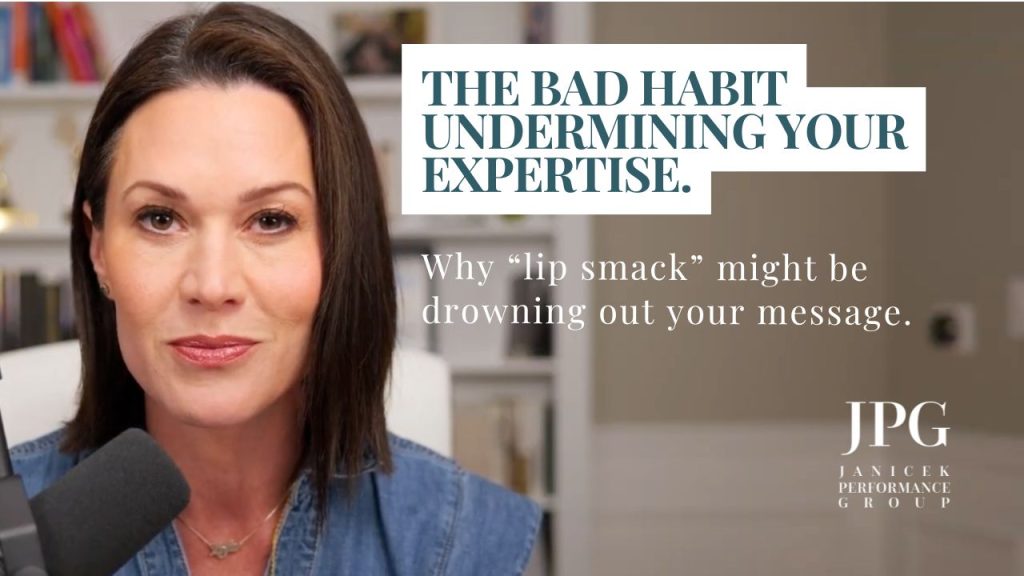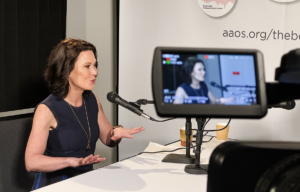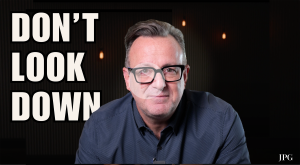Why “Lip Smack” Might Be Drowning Out Your Message
You’re presenting in front of your team.
You’ve nailed the strategy, the vision, the data.
But something is pulling the room’s focus—something small, barely noticeable, but persistent.
You finish a sentence… pause… smack.
Then another sentence… smack.
You may not even hear it. But your audience does.
It’s called lip smack—and once it’s present, it can chip away at your credibility, presence, and the power of your message.
At Janicek Performance Group, we work with high-performing executive leaders across industries, and this is one of the most common speaking habits we encounter in presentations, team meetings, earnings calls, media interviews, and keynotes. It’s subtle. It’s unintentional. And it’s absolutely fixable.
What Is Lip Smack—and Why Does It Happen?
Lip smack is the sound made when your lips part quickly—usually right before you speak again.
Lip smacking often shows up in these in-between spaces:
- After completing a sentence
- When transitioning to a new thought
- During moments of hesitation or silence
Why Do We Lip Smack?
1. Nervous Energy at Work
When we’re nervous, our bodies and minds look for small ways to self-soothe. For some, it’s pacing. For others, it’s filler words. Lip smack is often a way to “reset” and buy time before speaking again.
2. Dehydration in Disguise
If you’re even mildly dehydrated, your mouth produces less saliva—making it harder to speak comfortably. You may find yourself subconsciously trying to generate saliva between thoughts, and that motion creates the sound.
3. A Hidden Habit That Sticks
The more you speak in high-pressure environments, the more likely certain habits will creep in—especially if you’re not reviewing footage or receiving regular feedback. Lip smack is one of those habits that often goes undetected… until it’s pointed out.
Why It Matters in High-Stakes Communication
You may be thinking: It’s just a small sound—why does it matter?
Because presence is made up of moments.And in leadership communication, small distractions can have big consequences.
We want your audience focused on:
- Your vision
- Your authority.
- Your clarity.
- Your call to action.
Not on a repeated sound that breaks the rhythm of your message or distracts from the gravity of your words.
In a world where every second of attention matters, lip smack can create unnecessary friction—especially in boardrooms, virtual meetings, or during keynotes that are being recorded or livestreamed.
So, What’s the Fix to Lip Smacking?
The good news? This isn’t about being perfect.
You don’t need to sound like a robot or erase your personality.
This is about showing up with presence and intention.
Here’s what we recommend:
1. Build Awareness
Watch a recording of your next presentation. Do you hear the lip smack? If so, notice when it shows up. Is it between thoughts? After a question? During transitions?
Awareness alone often reduces the habit significantly.
2. Hydrate
It sounds simple, but increasing your water intake leading up to (and during) speaking engagements can make a huge difference.
3. Breathe and Pause Intentionally
Often, lip smack is a filler. Instead, try this: complete your sentence and simply pause.
Let the silence do some of the work. It builds drama. It shows control. It signals leadership.
Final Thought
Your voice is one of your most powerful leadership tools.
And when used intentionally, it builds trust, drives decisions, and inspires action.
Lip smack doesn’t define you.
But when it’s present, it can dilute your message.
The best part? Once you’re aware of it, it’s entirely within your control.
A small shift—big impact.
At Janicek Performance Group, we see this all the time—even among the most seasoned executive leaders. Lip smack is subtle, unintentional, and surprisingly common in high-stakes settings like presentations, earnings calls, and media interviews.





